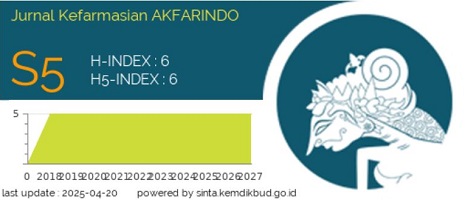FORMULASI GRANUL EFFERVESCENT DARI KUNYIT (Curcumae domestica) DAN ASAM JAWA (Tamarindus indica)
Abstract
Effervescent dosage form is another way to develop attractive soft drink products and provide variety in presentation because apart from being practical, it can also give a sparkle effect or a soda-like taste and can also cover some unwanted flavors of certain ingredients. The benefits of Jamu Turmeric Tamarind have been proven empirically. Jamu Turmeric is efficacious as an antibiotic, preventing sprue, analgesic (relieves pain), antipyretic (lowers body temperature during fever), and anti-inflammatory. The purpose of this research was to formulate and evaluate the physical properties of effervescent granules from turmeric (Curcumae domestica) and tamarind (Tamarindus indica). This type of research is an experimental study conducted to formulate turmeric (Curcumae domestica) and tamarind (Tamarindus indica) in the dosage form of effervescent granules in 2 formula forms with varying acid concentrations and then evaluate their physical properties. The evaluation of granules includes water content test, angle of repose test, flow rate test, compressive density test, dispersion time test and pH test. The results showed that turmeric (Curcumae domestica) and Tamarind (Tamarindus indica) could be formulated in effervescent granule dosage form. For the flow velocity test, it was found that the flow properties of the granules were low in the two formulations
References
Ardiyanto, W. N. (2017). Review: Konservasi Keanekaragaman Hayati Melalui Tanaman Obat Dalam Hutan Di Indonesia Dengan Teknologi Farmasi: Potensi Dan Tantangan. Jurnal Sains Dan Kesehatan, 1(7), 377–383.
Astuti, R. D., & Wahyu, A. W. (2016). Formulasi dan Uji Kestabilan Fisik Granul Effervescent Infusa Kulit Putih Semangka. Jurnal Kesehatan, 11(1), 162–171.
Geilisa, S. U. (2017). Pembuatan Serbuk Effervescent Biji Pepaya (Carica papaya L.) (Kajian Konsentrasi Dekstrin Dan Asam Sitrat). Universitas Brawijaya.
Ingsih, I. S., Winaktu, G., Teknik, F., Malang, U. I., Candirenggo, K., & Singosari, K. (2020). Pembuatan Jamu Tradisional Kunyit Asam Sebagai Minuman Peningkat Daya Imunitas Tubuh Pada Masa Pandemi Covid-19. Prosiding Seminar Nasional Abdimas Ma Chung, 328–339.
Lachman, Leon.dkk. 2008. Teori dan Praktek Farmasi Industri 2. UIPress.Jakarta.
Mulyani, S., Admadi Harsojuwono, B., & Kadek Diah Puspawati, G. A. (2014). Potensi Minuman Kunyit Asam (Curcuma domestica Val. - Tamarindus indica L.) Sebagai Minuman Kaya Antioksidan. AGRITECH, 34, 65–71.
Mutiah, R. (2015). Evidence Based Kurkumin Dari Tanaman Kunyit (Curcuma longa) Sebagai Terapi Kanker Pada Pengobatan Modern. Jurnal Farma Sains, 1(1), 28–41.
Permata, D. A., & Sayuti, K. (2016). Pembuatan Minuman Serbuk Instan Dari Berbagai Bagian Tanaman Meniran (Phyllanthus niruri). Jurnal Teknologi Pertanian Andalas, 20.
Pulungan, H.M. 2004. Membuat effervescent Tanaman Obat. TrubusAgrisarana. Surabaya
Sari, S. M., & Mareta, A. (2020). Pengaruh Pemberian Jamu Kunyit Asam Dengan Penurunan Nyeri Haid Pada Remaja Putri Di Man 3 Palembang Tahun 2019. STIK Siti Khadijah Palembang, X(1), 5–7.
Wulandari, R. A., & Azrianingsih, R. (2014). Etnobotani Jamu Gendong Berdasarkan Persepsi Produsen Jamu Gendong di Desa Karangrejo, Kecamatan Kromengan, Kabupaten Malang. Jurnal Biotropika, 2, 198–202. https://doi.org/10.3956/2009-30.1
Copyright (c) 2023 Arisanty Arifuddin, M. Faathir Al Akram, Ismail Ibrahim (Author)

This work is licensed under a Creative Commons Attribution-ShareAlike 4.0 International License.















